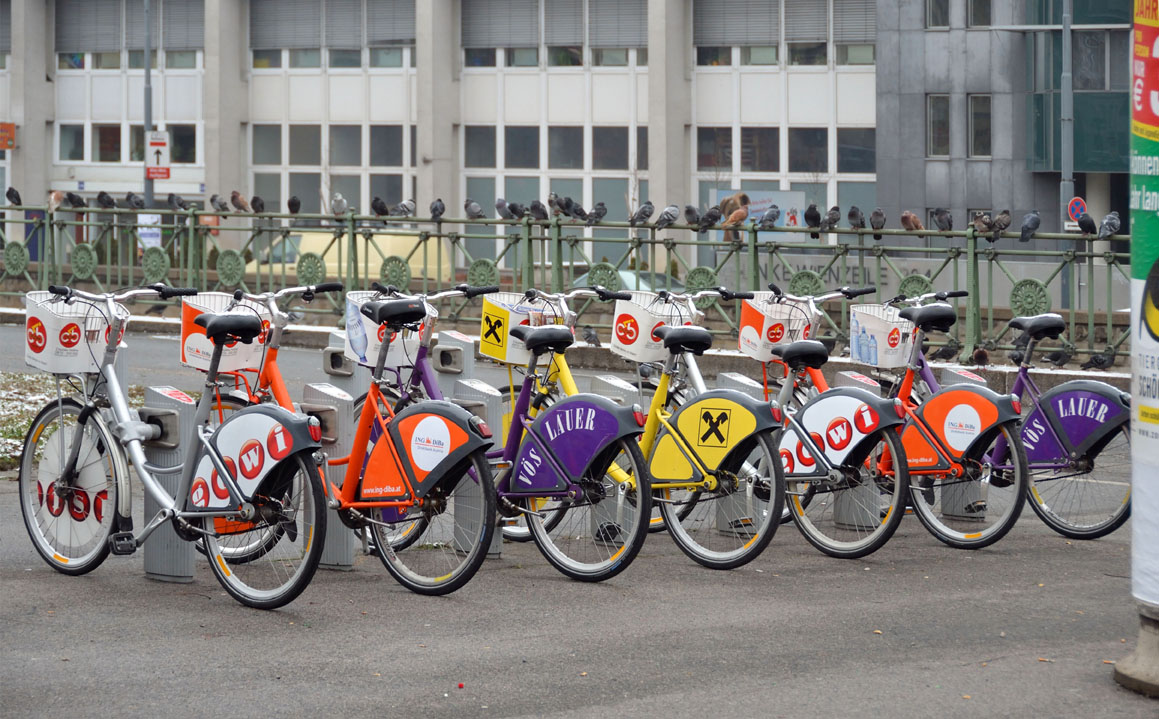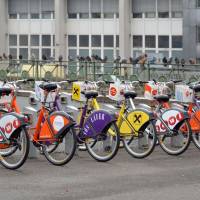On the Praterstern, where cars, buses and trams converge from several busy streets on a road that loops around Vienna's central train station, a new digital counter stands under the eye of the Riesenrad Ferris wheel.
It's about the size of a bus stop advertising hoarding and picks out passing bicycle wheels from a sensor in the pavement.
With a rumpled grey overcoat over his suit and a cycling helmet covering his grey hair, Wolfgang Dvorak excitedly explains that the 2,072 figure on display marks the number of bicycles that have passed this point so far today. "This is great, great! Measuring cyclists is making cycling visible, making people notice," says Dvorak. "It's very important, especially at city crossings like this. Just 14 days ago it was done, and the marking of the cycle lane here and the cycle signing. This is showing people that Vienna is cycling."
Dvorak, the director of last week's Velo-city, an annual conference that has brought more than 1,000 cycling experts and 330 speakers from around the world to Austria's capital, is giving an impromptu tour of the city's new bike-friendly spots, traveling by Citybike — a public bike-rental system available at some 100 automatic stations around the streets.
There are dozens of new private rental bike companies springing up too, including many specializing in e-bikes, electric-powered cycles for those more cautious about their fitness or ability levels, which can be charged for free at charging points across the capital.
Vienna is in the middle not only of its own "Year of Cycling," but also of an ambitious five-year plan to tempt its citizens out of cars and on to saddles. Faced with ever-growing traffic, as well as unenviable pollution levels and the rising costs of fuel, the city has determined to learn from progressive cycling capitals such as Munich, Malmo, Copenhagen and Amsterdam, which have embraced biking culture.
Vienna is one of 60 cities to have signed up to the Charter of Brussels, which commits them to promoting cycling and setting clear targets in road safety and in achieving a 15 percent "modal share" — the percentage of trips made by bicycle out of the total number of trips made by city-dwellers. In the United Kingdom only Bristol, in southwest England, and Edinburgh, which holds its first festival of cycling this weekend, have signed up, but the interest from mainland Europe, including many in the east, is phenomenal.
"We have now in Vienna about 5 percent to 6 percent modal share," says Dvorak. "We aim to double that by 2015. We are working on many infrastructure changes to facilitate urban cycling. The situation in general is that we are a growing population and we have no room any more. We need to create space and stop congestion, air pollution. Look at these terrible floods we are seeing at the moment; it is no longer an option to ignore climate change."
The television news in Austria and neighboring Slovakia, the Czech Republic, Hungary and Germany is full of images of flooded homes and businesses, and the Danube and Elbe have swollen with record levels of rainfall. Whatever the meteorologists and scientists say is the cause of the unseasonal weather, people here are talking and worrying about climate change.
It is being reflected in the housing being built here. Sustainability is a key factor and new developments are being planned around not just energy use but also the times of journeys to work and access to cycle networks.
For people living in cities, space to park a bike securely can be a major obstacle, which is why Vienna has just completed a pilot project called Bike City — a block of 100 flats for middle-income people, with wide communal hallways and lifts with bike racks outside each front door and bike stores on every floor.
Michael Szeiler, an Austrian traffic planning expert, is one of the first residents to have moved in. "The rents here are affordable because the builders have saved money by not having car parking — they have built only 50 spaces, rather than one per flat, as is usual. People still have cars," he says, "but people who live here make 25 percent of all trips by bicycle, as opposed to 6 percent of other Viennese."
Szeiler has been working on projects to link residential areas by cycle. At hotspots, traffic lights set with detectors are programmed to tell when cars are coming and to give priority for cyclists, so that they do not have to keep stopping and starting their journeys. The city is investing in infrastructure, the second main shopping street is being made car free, with pedestrian and cycle shared zones, and local politicians point to the fact that at €4.5 million it is only 5 percent of the annual road budgets.
Maria Vassilakou is the deputy mayor of Vienna with responsibility for urban planning. "Vienna is the fastest-growing city within German-speaking Europe, and if we continue with the policy of one person, one car, then we will become one traffic jam," she says.
"Cycling is about reducing congestion and creating space. We have set ambitious targets, especially in a city where you never know what the weather will be, but it is crucial to our survival to double the number of people cycling by 2015. It is crucial to make a swift change to modern mobility, and all ways lead to the bicycle."
She admits that some moves have been controversial — the city intends ripping out parking spaces to make space for cycle lanes, and they also mix pedestrians and bikes in the same spaces. "This is a hot issue" she says, "but in every city in the world there is conflict between cycling and cars, and you have to work hard at convincing people that their daily lives will improve. We have to be creative. We also have to encourage people to be respectful of each other."
But the arguments in favor of cycling have convinced many younger Austrians, among whom bicycles are becoming trendy, with a burgeoning market for old and especially notable bikes. They are also becoming collectable, and Vienna had an exhibition, Tour du Monde, opening last weekend in the Museum of Applied Arts (MAK).
MAK curator Thomas Geisler has chosen 50 examples from a collection of more than 210 bicycles owned by Michael Embacher, an architect with a pop star's standing in Austria. The selected machines are classics of design and very much of their time, says Geisler. "Each bicycle is a smart product of contemporary times, following all the material developments of the 21st century, the innovation and the techniques. They all have a story to tell. The bicycle is a machine for perception, slowing you down through a city."
Old bikes are turning up in Vienna's growing number of cycling shops, too, says Andrzej Felcak at the Radlager cycling cafe, showing a 20-year-old racer with a €1,200 price tag. Felcak is the chairman of Argus Radlobby — an organization that campaigns for cycling in Austria, lobbying for better routes and security.
"Its a thing that's really growing, bike collectors. For some it's maybe a nostalgia for the bike they wanted as a kid but they couldn't afford it then, like the old racing bikes or the Chopper.
"For the cycling community in Vienna, it is wonderful to see trends in urban cycling being reflected more widely so that the bike is becoming a mainstream method of transport. We can't solve our problems with cars, Feljak emphasizes.
"We want to push now the concept of cargo bikes, as they have in Copenhagen, for shop deliveries and also for making sales in the streets. So people can have stalls and perhaps selling things from bikes. There is a lot that can be done in the way of pedal-powered livelihoods, but people need to see it in action to really get the idea.
"If we look at Beijing, where a city of 5.4 million moved, 58 percent of them by bike, then we see that a bicycle as the currency of a city is something we could get, too."
Feljak pointed to older people or even disabled people having easier-geared bikes, tricycles and wheelchair attachments. "Your bicycle would fit not only your physical needs but your personality. It's your stage, your catwalk. There are new bicycle shops opening up in Vienna like mushrooms after the rain. Affordability is key, as is infrastructure, but little by little we get there."
However, out on the Praterstern, where the digital counter is moving, slowly, the cars are still dominant as the rain pours on the elegant streets.




